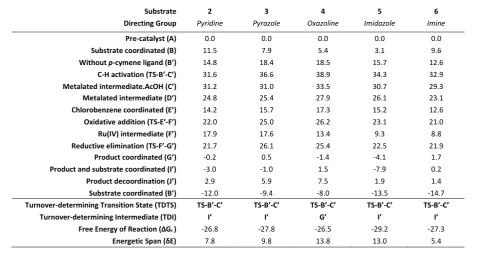Insights into mechanism and selectivity in ruthenium(II)-catalysed ortho-arylation reactions directed by Lewis basic groups
Full text
Figure


![Figure 4. Free energy surface for the arylation of 2-phenylpyridine with chlorobenzene, catalysed by [Ru(OAc)2(p-cymene)], in a mechanism where p-cymene remains bound to the metal centre throughout](https://thumb-us.123doks.com/thumbv2/123dok_us/1398830.92924/4.595.43.554.352.705/figure-surface-arylation-phenylpyridine-chlorobenzene-catalysed-mechanism-remains.webp)
![Figure 5. Free energy surface for the arylation of 2-phenylpyridine with chlorobenzene, catalysed by [Ru(OAc)2(p-cymene)], in a mechanism where p-cymene is not bound to the metal centre](https://thumb-us.123doks.com/thumbv2/123dok_us/1398830.92924/5.595.42.553.102.417/figure-surface-arylation-phenylpyridine-chlorobenzene-catalysed-cymene-mechanism.webp)
Related documents
calculations, we propose a possible alternative mechanism of the entire reaction cycle for the catalytic decomposition of hydrogen peroxide and the concomitant
Second, factual messages in AR advertisements were positively associated with consumers’ perceived information gratification, but the participants who saw factual message
• Dual Alternate- Example: Hurdler leading with left leg & taking 13 strides between would take 14 strides & use a right lead leg, then 14 again to get back to
The maximum span and deflection calculation is carried out and the piping system with intermediate support and without intermediate support is analysed in CAESAR II software..
The main conclusion of our study is that two microscopic transport models, UrQMD and QGSM, based on di ff erent mechanisms of string excitation and string fragmentation,
The structure of the paper is as follows: In Section 7.2, we introduce the N-body code and the initial conditions of the simulations. Section 7.3 is dedicated to the influence
Starting in 2004 KD was an Assistant Professor at the University of Miami: Miller School of Medicine; Department of Epidemiology and Public Health, and is currently the
Turning from the topological branes to D-branes in type II string theory, the well-known conditions for D-branes on Calabi-Yau manifolds to preserve a certain amount of

